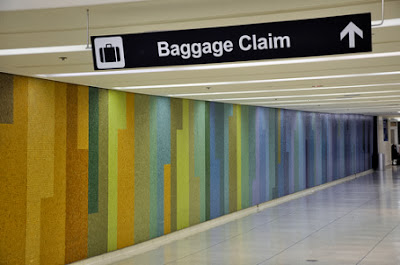This post will not be about the Long Beach Airport WPA mosaics, because I've blogged about them before, here and here.
No, today's post is for travelers. We have fifty-year-old mosaic walls along the concourses as LAX.
And travelers who see those walls are often going or coming to other airports that sport mosaics so we'll mention those as well.
But first: LAX.
Interior designer Charles Kratka installed the LAX walls--each 300 feet long--in 1961.
At the time, Kratka was the head of Interior Design for the airport, answering to William Pereira and Charles Luckman,
His idea was to make pedestrians think of the changing seasons, his daughter said. But as the Los Angeles Times pointed out in his 2007 obituary, tour guides today interpret them geographically. The blue as you start down the tunnel represent the sea, and the gold and brown tones are our nation's heartland. Apparently there is one vertical line of red right in the middle (I don't remember that), then at the other end, blue again: Sea to shining sea.
I've included a picture of that red stripe below, after the video.
Here's a YouTube video of the Terminal 4 mosaic--must be one of the few still open. From the comments I see that the fabricator was Alfonso Pardinas of Byzantine Mosaics in San Francisco.
It's also visible in Quentin Tarantino's Jackie Brown.
I haven't noticed them lately, so I was not surprised to read that many of these walkways were closed after 9/11, in the interest of tightened security. Not all are closed though.
In the early and mid-60s, my Grandma used to visit relatives in Utah once or twice a year, and walking along those corridors to take her to the plane or greet her on her return is a vivid memory. (That and her mink stole. She always broke that out to travel in style.)
After the 60s, they looked very dated to me--not bright or curvy enough to compete with more psychedelic designs. But 50s stuff--or more properly, Mid Century Moderne--is very much back in style now, so people can appreciate these mosaics once more.
The two pictures of LAX's mosaic is borrowed from the DesignerNotes blog.
NOTE: I've since learned that these mosaics are claimed by artist Janet Bennett, who worked for Charles Kratka. She is trying to clear the misperception that he designed these walls, and you can read more about that in my later blog post.
Now as to other airports:
A Wall Street Journal piece by Scott McCartney titled "Airports for Art Lovers" pointed out a few mosaics among the sculptures, light shows, and murals that ornament our terminals (LAX's mosaics did not get a mention.--his focus was on art installed in the last decade). He tells how many factors have combined since 9/11 to create areas--large open atriums, for example--that are ideal for art.
So here are some mosaics from airports around the country:
First, at Reagan International Airport in Washington DC, on Concourse C and Concource B, there are several floor mosaics in the forms of medallians worthy of your attention. The pictures are from the Public Art Photo Albums of the Metro Washington Airports Authority. There are man more pictures and more artists, so please take a look.
The first is based on a map of the Chesapeake Bay, by artist Joyce Kozloff:
The second is by Michele Oka Doner: It's called "Flight" and is of terrazzo and cast bronze:
Moving on to Miami International, another work by Michele Ok Doner is titled "A Walk on the Beach," which was done in the early 90s. Two thousand cast bronze images reflect the sea life of South Miami Beach:
Here is one from Lambert St. Louis Airport called "New Village" by artist Alicia LaChance, a native of St. Louis:
This next one is on a staircase leading to the car rental facility in the Kansas City Airport (Missouri).
There are tons more. I may do another post on international mosaics, since airports in Russia, Tunisia, and other countries have beautiful mosaics.
I'll finish with some of the MANY mosaics at Dallas Ft. Worth Airport. More than 20 artists participated in creating mosaics, and you see thumbnails of all the different works (very frustrating, though, because the pictures don't link to more information).
The Dallas-Ft Worth airport is also full of sculpture, glass and much more.
This particular 20-ft wide medallions in Terminal D shows cypress trees and snowy egrets, and is by artist Arthello Beck.
The "Concentric Orbs" are by Ted Kincaid, 22 feet across.





























